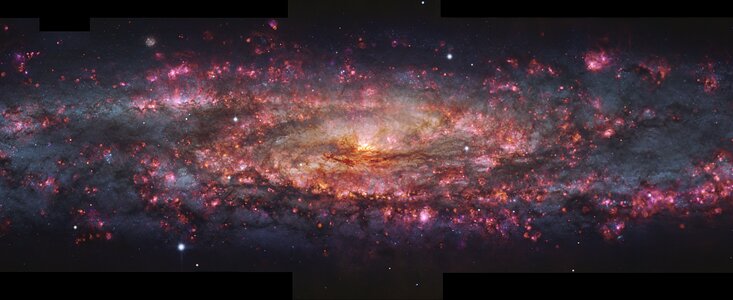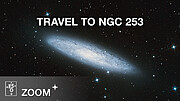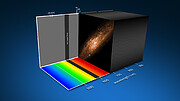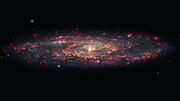Persbericht
Astronomen maken meest detailrijke ‘duizendkleurenfoto’ van een sterrenstelsel
18 juni 2025
Astronomen hebben een galactisch meesterwerk afgeleverd: een detailrijke opname van het Sculptor-stelsel waarop nooit eerder waargenomen structuren te zien zijn. Met behulp van de Very Large Telescope (VLT) van de Europese Zuidelijke Sterrenwacht (ESO) hebben ze dit nabije sterrenstelsel in duizenden kleuren tegelijk waargenomen. Door van elk stukje enorme hoeveelheden gegevens vast te leggen, maakten ze een momentopname van het leven van de sterren in het Sculptor-stelsel.
‘Sterrenstelsels zijn ongelooflijk complexe systemen die we nog steeds niet goed begrijpen’, zegt ESO-onderzoeker Enrico Congiu, die de leiding had over een nieuw onderzoek van Sculptor voor Astronomy & Astrophysics. Sterrenstelsels kunnen enorm groot worden: tot wel honderdduizenden lichtjaren. Maar hun evolutie hangt af van gebeurtenissen die zich op veel kleinere schalen afspelen.
‘Het Sculptor-stelsel is gunstig gepositioneerd’, zegt Congiu. ‘Het is nabij genoeg om zijn interne structuur op te lossen en zijn ‘bouwstenen’ ongelooflijk gedetailleerd te bestuderen, maar tegelijkertijd groot genoeg om het als één geheel te kunnen zien.’
De bouwstenen van een sterrenstelsel – sterren, gas en stof – zenden licht uit in verschillende kleuren. Dus hoe meer kleurschakeringen een opname van een sterrenstelsel bevat, des te meer kunnen we te weten komen over het inwendige van het stelsel. Waar conventionele opnamen slechts een handvol kleuren bevatten, bestaat deze nieuwe kaart van het Sculptor-stelsel uit duizenden. Dit vertelt astronomen alles wat ze moeten weten over de sterren, het gas en het stof in het sterrenstelsel, zoals hun leeftijd, samenstelling en beweging.
Het Sculptor-stelsel, ook bekend als NGC 253, is elf miljoen lichtjaar van ons verwijderd. Om deze kaart van het stelsel te kunnen maken, hebben de onderzoekers het meer dan vijftig uur lang waargenomen met het (MUSE)-instrument (Multi Unit Spectroscopic Explorer) van ESO’s Very Large Telescope. Voor het maken van de bijna 65.000 lichtjaar brede kaart moest het team meer dan honderd opnamen samenvoegen.
Volgens co-auteur Kathryn Kreckel van de Universiteit van Heidelberg (Duitsland), maakt dit de kaart tot een krachtig hulpmiddel: ‘We kunnen inzoomen om gebieden te onderzoeken waar zich afzonderlijke sterren vormen, maar ook uitzoomen om het sterrenstelsel als geheel te bestuderen.’
Bij hun eerste analyse van de gegevens ontdekten de astronomen ongeveer vijfhonderd planetaire nevels: gebieden van gas en stof afkomstig van stervende zonachtige sterren in het Sculptor-stelsel. Mede-auteur Fabian Scheuermann, promovendus aan de Universiteit van Heidelberg, plaatst dit aantal in perspectief: ‘Buiten onze eigen kosmische achtertuin hebben we meestal te maken met minder dan honderd detecties per sterrenstelsel.’
Vanwege hun specifieke eigenschappen kunnen planetaire nevels worden gebruikt als ‘meetlatten’ waarmee de afstanden van hun moederstelsels kunnen worden bepaald.
‘Door planetaire nevels op te sporen, kunnen we de afstand verifiëren van het sterrenstelsel waar ze deel van uitmaken – een cruciaal stukje informatie waar de rest van de studies van het sterrenstelsel van afhangt’, zegt Adam Leroy, professor aan Ohio State University in de VS en mede-auteur van het onderzoek.
Toekomstige projecten waarbij de kaart wordt gebruikt, zullen onderzoeken hoe gas door het sterrenstelsel stroomt, van samenstelling verandert en overal sterren vormt. ‘Hoe zulke kleinschalige processen zo’n grote impact kunnen hebben op een sterrenstelsel dat duizenden keren groter is, is nog steeds een raadsel’, zegt Congiu.
Meer informatie
De resultaten van dit onderzoek zijn te vinden in een artikel dat voor publicatie in Astronomy & Astrophysics is geaccepteerd.
Het onderzoeksteam bestaat uit: E. Congiu (Europese Zuidelijke Sterrenwacht, Chili [ESO Chili]), F. Scheuermann (Astronomisches Rechen-Institut, Zentrum für Astronomie der Universität Heidelberg, Duitsland [ARI-ZAH]), K. Kreckel (ARI-ZAH), A. Leroy (Department of Astronomy en Center for Cosmology and Astroparticle Physics, Ohio State University [OSU], VS), E. Emsellem (Europese Zuidelijke Sterrenwacht, Duitsland [ESO Garching] en Univ. Lyon, Univ. Lyon1, ENS de Lyon, CNRS, Centre de Recherche Astrophysique de Lyon, Frankrijk), F. Belfiore (INAF – Osservatorio Astrofisico di Arcetri, Italië), J. Hartke (Finnish Centre for Astronomy with ESO [FINCA] en Tuorla Observatory, Department of Physics and Astronomy [Tuorla], University of Turku, Finland), G. Anand (Space Telescope Science Institute, VS), O.V. Egorov (ARI-ZAH), B. Groves (International Centre for Radio Astronomy Research, University of Western Australia, Australië), T. Kravtsov (Tuorla en FINCA), D. Thilker (Department of Physics and Astronomy, Johns Hopkins University, VS), C. Tovo (Dipartimento di Fisica e Astronomia ‘G. Galilei’, Universit'a di Padova, Italië), F. Bigiel (Argelander-Institut für Astronomie, Universität Bonn, Duitsland), G.A. Blanc (Observatories of the Carnegie Institution for Science, VS, en Departamento de Astronomía, Universidad de Chile, Chili), A.D. Bolatto en S.A. Cronin (Departement Astronomie, University of Maryland, VS), D.A. Dale (Department of Physics and Astronomy, University of Wyoming, VS), R. McClain (OSU), J.E. Méndez-Delgado (Instituto de Astronomía, Universidad Nacional Autónoma de México, Mexico), E.K. Oakes (Department of Physics, University of Connecticut, VS), R.S. Klessen (Universität Heidelberg, Zentrum für Astronomie, Institut für Theoretische Astrophysik en Interdisziplinäres Zentrum für Wissenschaftliches Rechnen, Duitsland, Center for Astrophysics Harvard & Smithsonian, VS, en Elizabeth S. en Richard M. Cashin Fellow aan het Radcliffe Institute for Advanced Studies van de Harvard Universiteit, VS) E. Schinnerer (Max-Planck-Institut für Astronomie, Duitsland), T.G. Williams (University of Connecticut, VS) en Richard M. Cashin Fellow aan het Radcliffe Institute for Advanced Studies aan de Harvard Universiteit, VS) E. Schinnerer (Max-Planck-Institut für Astronomie, Duitsland), T. G. Williams (Onderafdeling Astrofysica, Faculteit Natuurkunde, Universiteit van Oxford, VK).
De Europese Zuidelijke Sterrenwacht (ESO) stelt wetenschappers van over de hele wereld in staat om de geheimen van het heelal te ontdekken, ten bate van iedereen. Wij ontwerpen, bouwen en exploiteren observatoria van wereldklasse die door astronomen worden gebruikt om spannende vragen te beantwoorden en de fascinatie voor astronomie te verspreiden, en bevorderen internationale samenwerking op het gebied van de astronomie. ESO, in 1962 opgericht als intergouvernementele organisatie, wordt inmiddels gedragen door 16 lidstaten (België, Denemarken, Duitsland, Finland, Frankrijk, Ierland, Italië, Nederland, Oostenrijk, Polen, Portugal, Spanje, Tsjechië, het Verenigd Koninkrijk, Zweden en Zwitserland) en door het gastland Chili, met Australië als strategische partner. Het hoofdkwartier van de ESO en haar bezoekerscentrum en planetarium, de ESO Supernova, zijn gevestigd nabij München in Duitsland, maar onze telescopen staan opgesteld in de Chileense Atacama-woestijn – een prachtige plek met unieke omstandigheden voor het doen van hemelwaarnemingen. ESO exploiteert drie waarnemingslocaties: La Silla, Paranal en Chajnantor. Op Paranal staan ESO’s Very Large Telescope en Very Large Telescope Interferometer, evenals surveytelescopen zoals VISTA. Ook zal ESO op Paranal de Cherenkov Telescope Array South huisvesten en exploiteren – ’s werelds grootste en gevoeligste observatorium van gammastraling. Samen met internationale partners beheert ESO APEX en ALMA op Chajnantor, twee faciliteiten die de hemel waarnemen in het millimeter- en submillimetergebied. Op Cerro Armazones, nabij Paranal, bouwen wij ‘het grootste oog ter wereld’ – ESO’s Extremely Large Telescope. Vanuit onze kantoren in Santiago, Chili, ondersteunen wij onze activiteiten in het gastland en werken wij samen met Chileense partners en de Chileense samenleving.
Links
• Voor journalisten: abonneer je op onze persberichten in je eigen taal
• Voor wetenschappers: heb je een verhaal? Promoot je onderzoek
• Nieuwe ESO-analyse bevestigt: ernstige schade door gepland industrieel complex bij Paranal
Contact
Enrico Congiu
European Southern Observatory (ESO)
Santiago, Chile
E-mail: econgiu@eso.org
Kathryn Kreckel
Heidelberg University
Heidelberg, Germany
Tel: +49 6221 54-1859
E-mail: kathryn.kreckel@uni-heidelberg.de
Adam Leroy
The Ohio State University
Columbus, Ohio, USA
Tel: +1 614 292-1765
E-mail: leroy.42@osu.edu
Fabian Scheuermann
Heidelberg University
Heidelberg, Germany
E-mail: f.scheuermann@uni-heidelberg.de
Bárbara Ferreira
ESO Media Manager
Germany, Germany
Tel: +49 89 3200 6670
Mob: +49 151 241 664 00
E-mail: press@eso.org
Rodrigo Alvarez (press contact België)
ESO Science Outreach Network
en Planetarium, Royal Observatory of Belgium
Tel: +32-2-474 70 50
E-mail: eson-belgië@eso.org
Over dit bericht
| Persberichten nr.: | eso2510nl-be |
| Naam: | NGC 253, Sculptor Galaxy |
| Type: | Local Universe : Galaxy : Type : Barred |
| Facility: | Very Large Telescope |
| Instruments: | MUSE |
| Science data: | 2025A&A...700A.125C |
Our use of Cookies
We use cookies that are essential for accessing our websites and using our services. We also use cookies to analyse, measure and improve our websites’ performance, to enable content sharing via social media and to display media content hosted on third-party platforms.
ESO Cookies Policy
The European Organisation for Astronomical Research in the Southern Hemisphere (ESO) is the pre-eminent intergovernmental science and technology organisation in astronomy. It carries out an ambitious programme focused on the design, construction and operation of powerful ground-based observing facilities for astronomy.
This Cookies Policy is intended to provide clarity by outlining the cookies used on the ESO public websites, their functions, the options you have for controlling them, and the ways you can contact us for additional details.
What are cookies?
Cookies are small pieces of data stored on your device by websites you visit. They serve various purposes, such as remembering login credentials and preferences and enhance your browsing experience.
Categories of cookies we use
Essential cookies (always active): These cookies are strictly necessary for the proper functioning of our website. Without these cookies, the website cannot operate correctly, and certain services, such as logging in or accessing secure areas, may not be available; because they are essential for the website’s operation, they cannot be disabled.
Functional Cookies: These cookies enhance your browsing experience by enabling additional features and personalization, such as remembering your preferences and settings. While not strictly necessary for the website to function, they improve usability and convenience; these cookies are only placed if you provide your consent.
Analytics cookies: These cookies collect information about how visitors interact with our website, such as which pages are visited most often and how users navigate the site. This data helps us improve website performance, optimize content, and enhance the user experience; these cookies are only placed if you provide your consent. We use the following analytics cookies.
Matomo Cookies:
This website uses Matomo (formerly Piwik), an open source software which enables the statistical analysis of website visits. Matomo uses cookies (text files) which are saved on your computer and which allow us to analyze how you use our website. The website user information generated by the cookies will only be saved on the servers of our IT Department. We use this information to analyze www.eso.org visits and to prepare reports on website activities. These data will not be disclosed to third parties.
On behalf of ESO, Matomo will use this information for the purpose of evaluating your use of the website, compiling reports on website activity and providing other services relating to website activity and internet usage.
Matomo cookies settings:
Additional Third-party cookies on ESO websites: some of our pages display content from external providers, e.g. YouTube.
Such third-party services are outside of ESO control and may, at any time, change their terms of service, use of cookies, etc.
YouTube: Some videos on the ESO website are embedded from ESO’s official YouTube channel. We have enabled YouTube’s privacy-enhanced mode, meaning that no cookies are set unless the user actively clicks on the video to play it. Additionally, in this mode, YouTube does not store any personally identifiable cookie data for embedded video playbacks. For more details, please refer to YouTube’s embedding videos information page.
Cookies can also be classified based on the following elements.
Regarding the domain, there are:
- First-party cookies, set by the website you are currently visiting. They are stored by the same domain that you are browsing and are used to enhance your experience on that site;
- Third-party cookies, set by a domain other than the one you are currently visiting.
As for their duration, cookies can be:
- Browser-session cookies, which are deleted when the user closes the browser;
- Stored cookies, which stay on the user's device for a predetermined period of time.
How to manage cookies
Cookie settings: You can modify your cookie choices for the ESO webpages at any time by clicking on the link Cookie settings at the bottom of any page.
In your browser: If you wish to delete cookies or instruct your browser to delete or block cookies by default, please visit the help pages of your browser:
Please be aware that if you delete or decline cookies, certain functionalities of our website may be not be available and your browsing experience may be affected.
You can set most browsers to prevent any cookies being placed on your device, but you may then have to manually adjust some preferences every time you visit a site/page. And some services and functionalities may not work properly at all (e.g. profile logging-in, shop check out).
Updates to the ESO Cookies Policy
The ESO Cookies Policy may be subject to future updates, which will be made available on this page.
Additional information
For any queries related to cookies, please contact: pdprATesoDOTorg.
As ESO public webpages are managed by our Department of Communication, your questions will be dealt with the support of the said Department.








